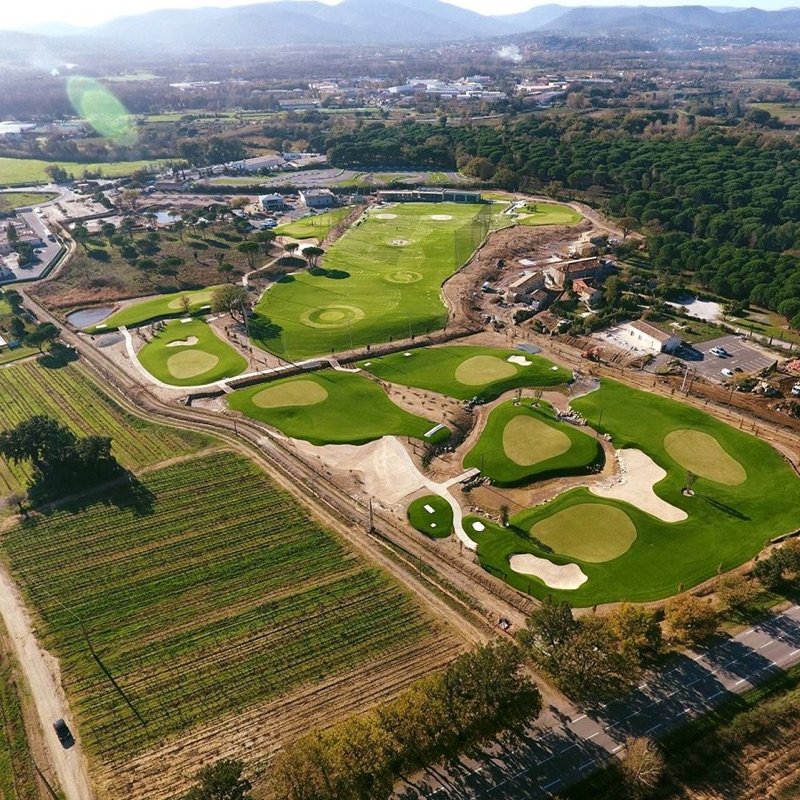From Natural to Synthetic: The Evolution of Golf Course Design.
Elevating golf courses with high-tech synthetic turf.
For those in the golf industry, the shift from natural to synthetic turf is more than a trend. Switching golf course grass to synthetic turf is a strategic decision with numerous benefits.
With advanced TºCool artificial turf, golf courses can now offer a superior playing experience, combining aesthetics, functionality, and environmental responsibility.
In this blog, we unpack the reasons why synthetic turf is redefining golf course standards, and how it can dramatically improve both the quality of play and operational efficiency.
Keep reading to discover how your course can benefit from this modern approach to golf greenery.
TºCool Technology Infused Golf Course in St. Tropez, France.
The drive towards synthetic turf.
The journey of synthetic turf from a novel idea to a widely accepted standard in sports mirrors the current trajectory in the world of golf. Historically, the introduction of synthetic turf for sports was met with skepticism and resistance, particularly in sports where tradition held a strong foothold.
However, as the technology advanced, the benefits of synthetic turf became undeniable, leading to its gradual acceptance and eventual embracement. This path is now being mirrored in golf, a sport deeply rooted in tradition yet evolving with modern advancements.
Early adopters in the golf industry, recognizing the potential of synthetic greens, have been pivotal in shifting perceptions. These pioneers have demonstrated that synthetic turf can offer a playing experience on par with, if not superior to, natural grass.
The future of golf course design is being shaped by these innovations, with courses embracing synthetic solutions for their durability, low maintenance, and consistent playability. These trailblazers are changing the landscape, setting new standards in golf course quality and sustainability.
As synthetic turf gains momentum, it's becoming increasingly clear that its role in golf is a part of the sport's future. This shift is driven by the desire for more sustainable, cost-effective, and player-friendly courses, aligning perfectly with the evolving needs of the modern golfer and the environmental considerations of our times.
Environmental tee-off.
TºCool's 16/30 Golf Sand is a proprietary, high-quality, spherical and well rounded sand that allows for optimum shock absorbing and true ball roll. The roundness and sphericity, in combination with a reduced coefficient of friction, allows for consistent ball roll, as well as accepting and holding long distance shots. Not to mention, TºCool is the only proven and patented cooling technology for synthetic turf.
The transition from traditional golf course grass to synthetic greens marks a significant step forward in environmental stewardship.
Unlike natural grass used for golf courses, synthetic turf eliminates the need for harmful chemical fertilizers and pesticides, safeguarding local ecosystems from potential contamination. This shift resonates deeply with the growing eco-consciousness in the golf community, where the sustainability of the playing field is now as important as the game itself.
While synthetic greens contribute to water conservation – a critical aspect in many drought-prone regions – traditional golf greens demand extensive irrigation, a resource-intensive practice that synthetic turf smartly circumvents. Embracing cool turf technologies further enhances this environmental edge.
These advanced systems replicate the lush aesthetics and playability of natural grass while significantly reducing the course's ecological footprint. This innovation in golf course design offers a greener, more sustainable future, aligning the sport with modern environmental values.
A fairway of benefits.
The adoption of synthetic turf in golf courses is not just a trend – it’s a game-changer that’s here to stay. But, what are the advantages?
Lower costs
At the forefront is the significantly reduced requirement for golf course maintenance. The best artificial grass for golf putting greens and fairways brings an end to the laborious and costly tasks of watering, mowing, and fertilizing, prevalent in traditional golf course upkeep. This translates to substantial cost savings and a more efficient allocation of resources.
Year-round usage
Year-round playability is another standout benefit. Unlike natural turf, which can be rendered unplayable by adverse weather conditions, synthetic greens remain consistent and playable in all seasons. This reliability ensures golfers can enjoy their game without interruption, boosting both player satisfaction and course profitability.
Customizability
From a technical standpoint, synthetic turf shines with its customizable features. Golf courses can tailor the stimp value – a measure of green speed – to suit various play styles and difficulty levels. This flexibility extends to design as well, allowing courses to creatively shape greens and fairways in ways that natural turf limits.
Marketing potential
Synthetic greens also present unique marketing opportunities. They offer the potential to embed branding directly into the design, such as tufting a country club logo or incorporating sponsors' logos. Enhancing the aesthetic appeal of the course while opening new revenue streams, this turns each green into a potential billboard, offering an attractive value proposition to sponsors and partners.
Artificial turf is charting the course for the future.
This exploration of synthetic turf reveals its substantial environmental, financial, and performance benefits for golf courses. As the industry evolves, course owners and managers are encouraged to embrace this sustainable and innovative solution, ensuring their greens remain at the forefront of golf's exciting future.
And, with technology available that contributes to the longevity of the turf, ensuring it remains in pristine condition for longer periods, despite frequent use and varying weather conditions, making the switch is a no-brainer. If you want a high-quality, sustainable playing surface that meets the demands of both casual players and professionals alike, TºCool artificial turf technology is the solution for you.




